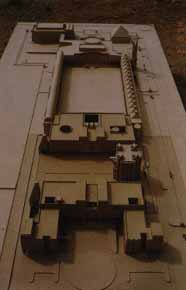IGNCA : Building in Making
The Indira Gandhi National Centre for the Arts, launched by late Sh. Rajiv Gandhi in November 1985, started its humble beginnings from seven cubicles in the Vigyan Bhavan Annexe. The Government of India was requested for more accommodation for the centre and after lot of efforts at the highest levels about 10,000 sq. feet of space in the Indian Oil Bhavan on Janpath vacated by the Indian Oil Corporation was offered. Dr. (Mrs.) Kapila Vatsyayan, then Secretary, Department of Arts, had an extremely difficult choice before her as to whether to accept the offer and move to the Indian Oil Bhavan or, in the alternative, decline the offer and practically close all options of getting space from the Directorate of Estates.
It was at this point that a suggestion was made that the ‘kitchen block’ of the erstwhile Air Force Mess, in its truncated shape, could provide shelter to the Centre. The remnant structure was full of furniture with heaps of dust and cobwebs. All-around lay debris of demolished blocks, rusted pipes, wires, leftover garbage of all sorts and, in addition, there were four blocks of servant quarters humming with large number of families of various categories of people living in the 208 tenements. It required an enormous courage for anyone to make such a suggestion and called for much greater vision, strength of mind and single-minded pursuit of a builder of an institution to accept such a suggestion. With no support system for its implementation, Dr. Vatsyayan opted for the latter situation and declined to move to the Indian Oil Bhavan having market all around and famous “Janpath” shops in its vicinity. On the one hand this was the critical situation about space for the Centre and on the other, for a massive building complex world-renowned architects were formulating their schemes, giving final touches to their design solutions.
It was at this point that a suggestion was made that the ‘kitchen block’ of the erstwhile Air Force Mess, in its truncated shape, could provide shelter to the Centre. The remnant structure was full of furniture with heaps of dust and cobwebs. All-around lay debris of demolished blocks, rusted pipes, wires, leftover garbage of all sorts and, in addition, there were four blocks of servant quarters humming with large number of families of various categories of people living in the 208 tenements. It required an enormous courage for anyone to make such a suggestion and called for much greater vision, strength of mind and single-minded pursuit of a builder of an institution to accept such a suggestion. With no support system for its implementation, Dr. Vatsyayan opted for the latter situation and declined to move to the Indian Oil Bhavan having market all around and famous “Janpath” shops in its vicinity. On the one hand this was the critical situation about space for the Centre and on the other, for a massive building complex world-renowned architects were formulating their schemes, giving final touches to their design solutions.
The Competition evoked the most enthusiastic response and over 600 eminent architects registered in the Competition from all over the world; 194 entries were actually received from 37 countries. On November 19, 1986 late Shri Rajiv Gandhi announced the award for the Competition. Prof. Ralph Larner, an Americal architect (who teaches) architecture at Princeton University) was adjudged the first prize winner. The prize-winning design comprised of the following buildings: Kala Nidhi (Reference Library), Kala Kosha (Research Wing); Sutradhara (Administration); Janapada Sampada (Tribal and Folk Art Centre); Exhibitiono Galleries; Residential Block; Indian Theatre (seating capacity 400); National Theatre (seating capacity 1200); and Concert Hall (seating capacity 2000).
In addition there will be Rock Art Galleries ‘Adi Drasya’ and a sound gallery ‘Adi Sravya’. The Centre will have three major Courts; around the Western Court will be the three theatres with opening to the Janpath. Around the eastern Court will be the buildings of Kala Nidhi, Sutradhara and Janpada Sampada, opening towards the Rajpath. Central Court will be a large landscaped space having Residential Block on the southern side and Exhibition Galleries on the northern side.
|
One of the unique features of the Building Complex is its simplicity. The buildings are fully integrated, yet the various buildings have a sense of autonomous existence – precisely the concept of IGNCA where we have a logo of intertwined svastika reflecting the integration and interdependence of various disciplines of human knowledge and human activity. Besides the architectural excellence, the Building Complex, as it is being planned and developed, shall have input from reputed consultants in the specialised fields, which will include acoustics, telecommunication, kitchen services, heating, ventilation and air-conditioning, electrical engineering, structural engineering, etc. After overcoming many hurdles, the construction of the Building Complex commenced in June 1993 and now one can see the Kala Nidhi Building coming up along the Man Singh road. The next group of buildings to be taken up for construction would be Sutradhara, Underground Parking ‘B’, Janapada Sampada, Exhibition Galleries and the Residential Block. – Basant Kumar |
|






